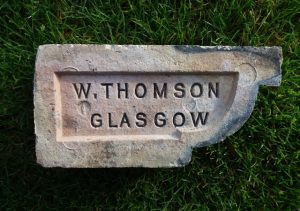Found by Michael Fallone in the Glasgow area.
Does anyone know the meaning of the symbols on the rear between the numbers – ?? and J
Wm Thomson, brickmaker, Crossbank Brick and Tile Works, 686 Aikenhead road, and Mallsmire Fire Brick Works, Polmadie; HHouse, 33 Queen Sq., Strathbungo.
I believe this will be Alexander Thomson’s son William, Thomson.
Alex. Thomson, Brickmaker, builder and contractor. 130 Pollokshaws Road, Glasgow and at Crossbank Brick and Tile Works. Ho 41 Cumberland Street.
This brick is 8 3/4″ long x 4 1/2″ deep.
This brick was recovered from the United Co-operative Baking Society biscuit factory, McNeil Street, Hutchesontown, Glasgow. It occupied the block encompassing McNeil Street, Ballater Street, Adelphi Street and Moffat Street. This particular brick is from the facade in Moffat Street and dates from c.1900.
The UCBS was founded in 1869 to supply bread to the city’s co-op branch stores. It had a large factory in McNeil Street in Hutchesontown which employed nearly 1,000 people by 1958. The advert notes that the UCBS baked 50 per cent of all the bread eaten in the city.
Co-operative societies played a large part in retail distribution in Glasgow. A 1950 census indicated they accounted for one-tenth of all retail sales in the city. Between 1938 and 1954 the combined membership of Glasgow’s eight co-op societies rose by nearly 50 per cent, from nearly 135,500 to over 210,000 people.
This advertisement depicts three students dressed up in a fancy dress for Charity Week holding a giant slice of bread. The importance of bread as the fuel of the city is demonstrated by the depictions of famous landmarks: the University of Glasgow; George Square and the shipyards.
Canmore
Canmore

.

Below – The width of the brick varies. Looking at the photo below, the back measures 3 ” wide and the front 3 1/4″ wide.

Below – 1939 – Advertisement for the United Co-operative Baking Society.









